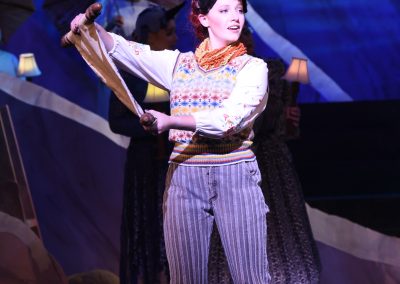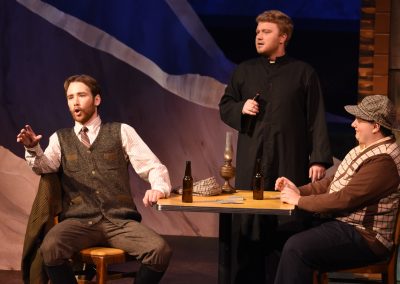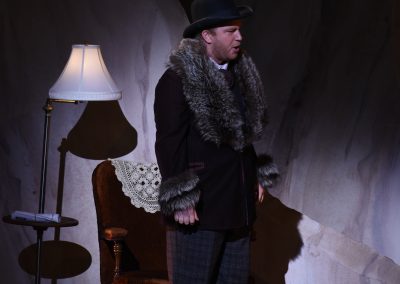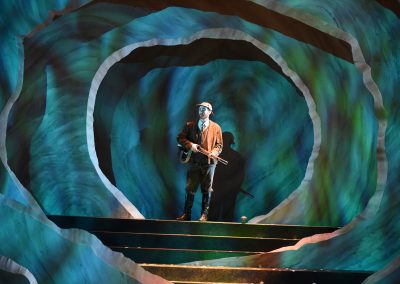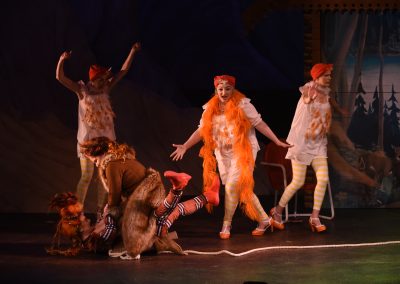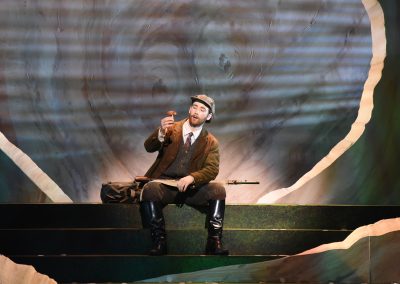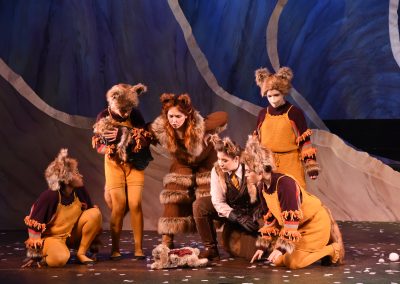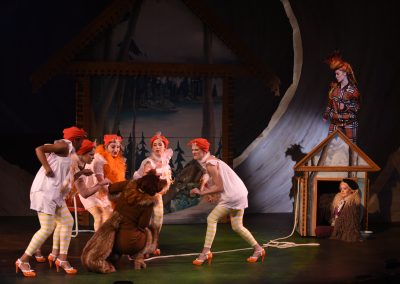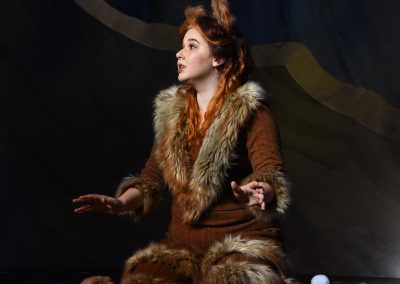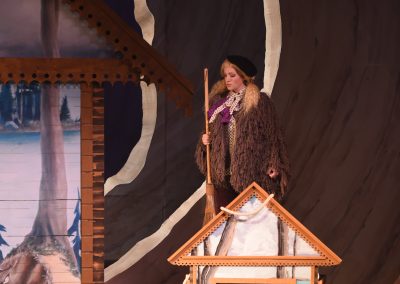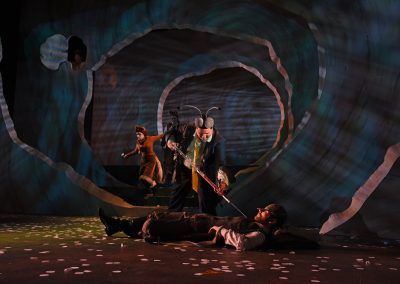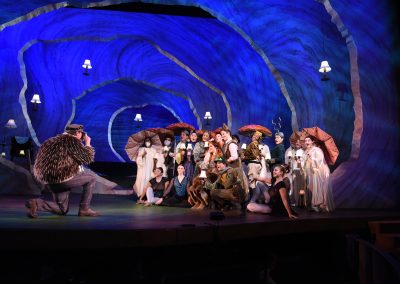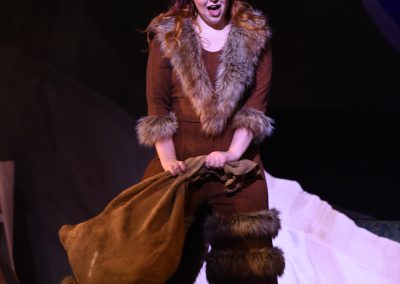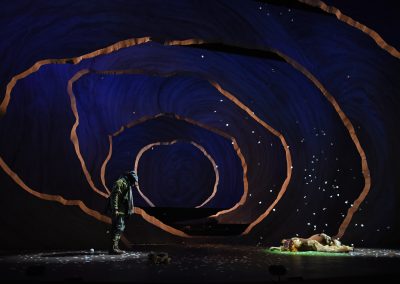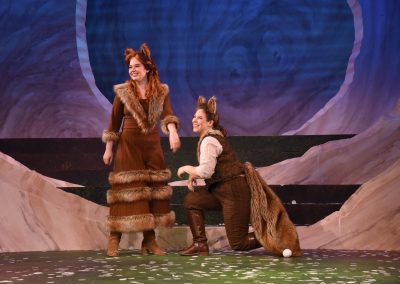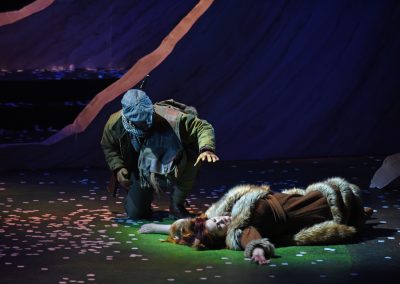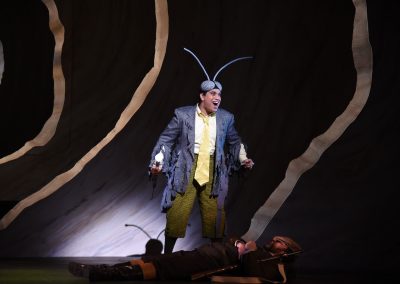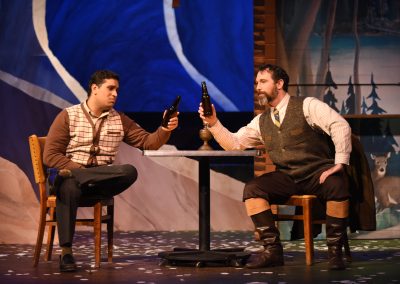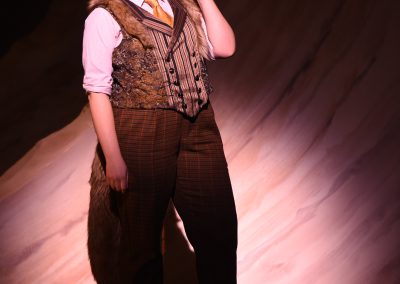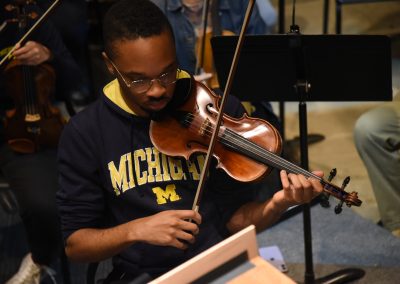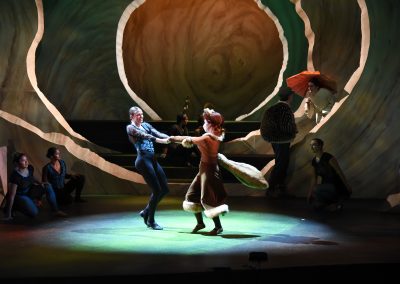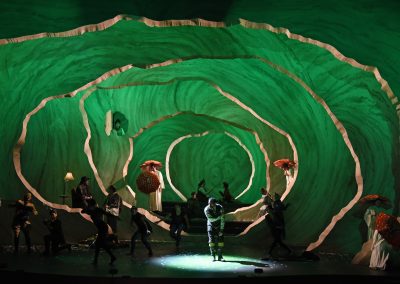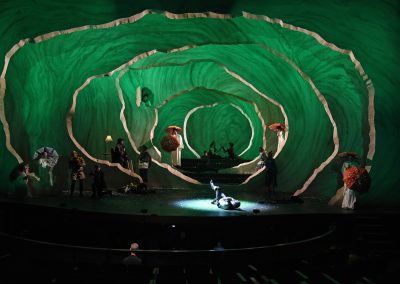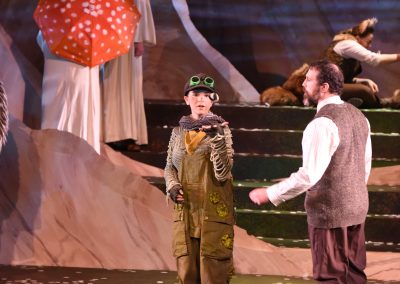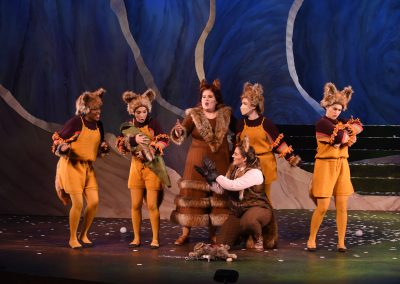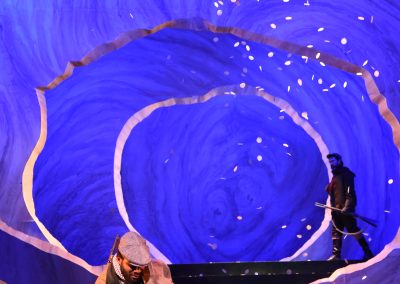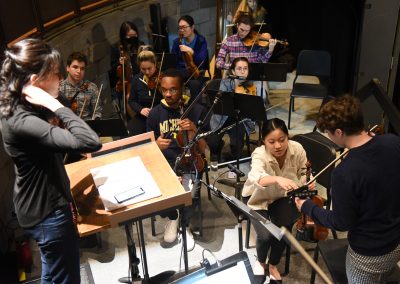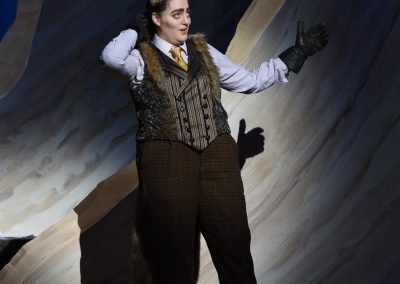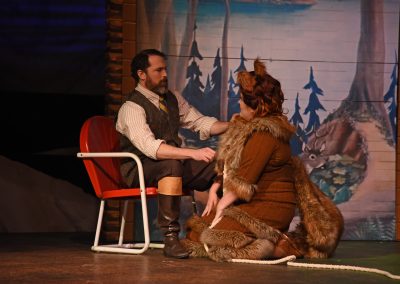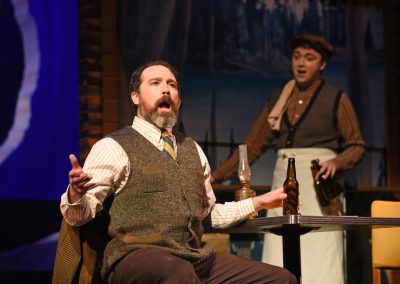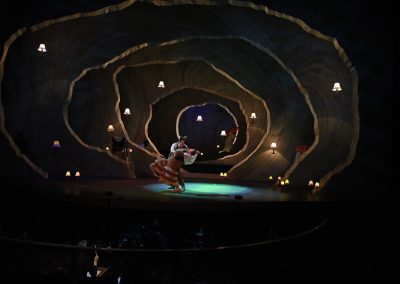SMTD Past Performances
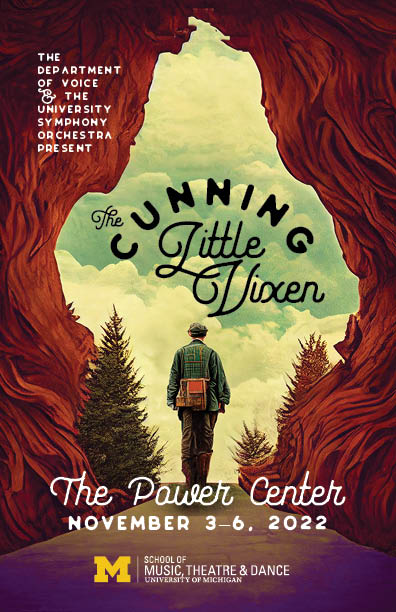
Creative Team
Director
Tara Faircloth
Music Director / Conductor
Kirk Severtson
Assistant Conductor^
Yeo Ryeong Ahn‡
Scenic Designer
Cameron Anderson
Costume Designer
Sarah M. Oliver
Lighting Designer
Rob Murphy
Czech Coaching
Timothy Cheek
Choreographer
Amy Chavasse
Dramaturg
Karin Waidley
Chorus Master
Benjamin Gaughran‡
Rehearsal Pianists / Coaches
Julian Grabarek‡ Kimia Rafieian‡
Fight Directors
Erik Dagoberg‡,
Atticus Olivet‡
Production Stage Manager
Kayleigh Laymon
^Yeo Ryeong Ahn conducted the performance on Sunday, November 6.
Cast
Thursday/Saturday
Revírník (Forester)
Noah B. Rogers
Bystrouška (Vixen)
Juliet Schlefer
Lisák (Fox)
Danielle Casós
Rechtor (Schoolmaster) / Komar (Mosquito)
Trevor Scott
Lapák (Dog) / Datel (Woodpecker)
Abigail Lysinger
Friday/Sunday
Revírník (Forester)
Robert Wesley Mason
Bystrouška (Vixen)
Colleen Cole Beucher
Lisák (Fox)
Antona Yost
Rechtor (Schoolmaster) / Komar (Mosquito)
Ian Pathak
Lapák (Dog) / Datel (Woodpecker)
Madeleine Buckley
All Performances
Harašta, a poacher
Tyrique McNeal
Farár (Parson) / Jezevec (Badger)
Cody Carlson
Kohout, a rooster / Jay
Annika De Jonge
Chocholka, a hen
Cinderella Ksebati
Forester’s wife / Owl
Aria Minasian
Pepík, the forester’s son
Darla Lowe
Frantík, Pepík’s friend
Megan Warburton
Pásek (Innkeeper) / Hedgehog
Spencer VanDellen
Pani Paskova, the innkeeper’s wife
Catherine Gispert
Cricket
Anne-Marie Atanga
Grasshopper
Pelagia Pamel
Frog
Victoria Rose Pinto
Little Vixen
Rebecca Clark
Dream Vixen
Ladina Schaller
Fox Cubs
Anne-Marie Atanga, Rebecca Clark,
Pelagia Pamel, Victoria Rose Pinto
Hens
Anne-Marie Atanga, Catherine Gispert, Darla Lowe, Megan Warburton
Chorus
Hallie Ackerman, Olivia Donahue, Justin Ingui, Veronica Nicole Koz, Javier F. Torres Delgado, Sumedha Vadlapudi, Jaxon Williams
Dragonflies (Dancers)
Audrey Deguia, Melisa Orduna,
Ladina Schaller, Kaitlyn Wilson
Orchestra
Violin I
Beau Henson**
Matthew Adams
Yuchen Cao
Zoe Fong
Alden Rohwer
May Tang
Violin II
Ellen Hayashi*
Zoe Dweck
Joshua Millet
Jolie Rebelo
Braden Thompson
Alex Vershinin
Viola
Hannah Langenbach* Luvyana Marquez
Diego Mieres
Cello
Emma Cary*
Benjamin Deighton
Emma Osterrieder
John Rose
Double Bass
Grant Phillips*
Connor Briskin
Flute
Isabella Carucci
Oboe
Daniel Severtson
Clarinet
Noah Pujol
Bassoon
Eddie Martinez
Trumpet
Gabriella Rock
Horn
Adam Julian
Zachariah Reed
Trombone
Arabella Olson
Percussion
John Tatara
Spencer Perilloux
Harp
Karlee Lanum
Keyboard (alternating performances)
Julian Grabarek
Kimia Rafieian
*Principal
Assistants to the Creative Team
Assistant Director Andrew Smith‡ | Assistant Lighting Designer William Webster‡
Co-Dramaturg Leo Kupferberg‡ | 1st ASM Elaina Veasey‡
2nd ASMs Chuck Gibson‡, Katie Kutzko‡, Caleb Quezon‡
Production Crew
Sound Engineer Roger Arnett
Hair and Makeup Supervisor Sam Whetstone
Assistant Master Electrician Brandon Malin
Shop Crews
Theatrical Lighting Abi Farnsworth, Jordan Pinet, Brandon Malin, Christian Mulville, Sydney Geysbeek, Elianna Kruskal, Megan Mondek, Alex Li, William Webster
Painting Ellie Vice & Theatre 250/252/261 students
Props Beatrix Dergis, Aquila Ewald, Dallas Fadul, Eli Hubbel, Rachael Hymowitz, Katie Kim, Lucy Knas, Alex Li, Audrey Tieman, Laurence Vance, and Theatre 250/252 students
Scenery (Walgreen Scene Shop) Niamh Sullivan, Sophia Severance, Cass Scott, Andy Blatt, Miles Hionis, Juliet Bornholdt, and Theatre 250/ 252 students
Costumes Esmay Pricejones, Ellie VanEngen, Kaytlin Sanchez, and Theatre 250/252/262 Students
Production Office Holly Adam, Marissa Honig, Trisha Stichler
Running Crew
Light Board Operator Anna Zhou
Supertitles Operator Maya Liu
Followspot Operator Austin Nedrow
Followspot Operator Haoyi Wen
Deck/Props Crew Sofia Deler, Tiara Partsch
Deck/Scenery Crew Brendan Dallaire, Jamie Mann, Diego Rodriguez
Wardrobe Crew Mila McCoy+, Kaitlyn Yi, Alex Humphreys, Lucy Knas
Wig/Makeup Crew Dallas Fadul+, Amy Helms
+Crew Head
Design & Production Faculty Advisors
Head of Design & Production Christianne Myers
Stage Management Nancy Uffner
Scenic Design Jungah Han, Kevin Judge
Costume Design Christianne Myers, Sarah M. Oliver, Christopher Vergara
Lighting Design Jess Fialko, Shelby Loera, Rob Murphy
Sound Design Henry Reynolds
Department of Voice
Chair
Scott Piper
Opera Faculty
Kathleen Belcher, Timothy Cheek, Abbigail Coté, Tara Faircloth (Guest Director), Kirk Severtson, Matthew Thompson, Mo Zhou
Voice Faculty
Freda Herseth, Stephen Lusmann, Caitlin Lynch, Amanda Majeski, Rose Mannino, Stanford Olsen, Scott Piper, George Shirley, Louise Toppin, Daniel Washington, Stephen West
Associated Faculty
Antonio Cuyler, Caroline Helton
Distinguished Visiting Artist
Thomas Hampson
Professors Emeriti
Willis Patterson, Carmen Pelton, George Shirley
University Productions Administrative Staff
Executive Director
Jeffrey Kuras
Administrative Specialist
Christine Eccleston
Administrative Assistant
Nathan Carrillo
Information Systems Manager
Henry Reynolds
Facilities Manager
Shannon Rice
Performance Halls
House Manager
Kelley Krahn
Lead Backstage Operations Manager
Dane Racicot
Senior Backstage Operations Manager
David Pickell
Backstage Operations Managers
Tiff Crutchfield, Alex Gay, Yvette Kashmer
University Productions Production Staff
Production Manager
Paul Hunter
Assistant Production Manager
Michelle Williams-Elias
Technical Director (Walgreen)
Richard W. Lindsay Jr.
Theatrical Scenery Manager
Chad Hain
Lead Scenic Carpenter
Devin Miller
Scenic Carpenter
Heather Udowitz
Charge Scenic Artist
Beth Sandmaier
Associate Theatrical Paint Manager
Madison Stinemetz
Theatrical Properties Manager
Patrick A. Drone
Senior Properties Artisan
Dan Erickson
Theatrical Lighting Manager
Heather Hunter
Associate Theatrical Lighting Manager
Baxter Chambers
Sound Designer/Engineer
Henry Reynolds
Costume Shop Manager
Laura Brinker
Assistant Costume Shop Manager
Leslie Ann Smith
Cutter/Drapers
Justin Collings, Seth Gilbert, TJ Williamson
Theatrical Stitchers
Rene Plante, Marcia Grace
Crafts Artisan
Elizabeth Gunderson
Costume Stock Manager
Theresa Hartman
Wardrobe Manager
Rossella Human
Resources
- About the Performance
- About the Authors
- Thoughts on The Cunning Little Vixen
- Download Program
- Land Acknowledgment
The performers in this production were students in the Department of Voice and the University Symphony Orchestra. The designers for this production were students, faculty, and/or guests of SMTD. Scenery, costumes, properties, sound, and lighting were realized by the students and staff of University Productions, the producing unit of the SMTD. Thank you for supporting our educational mission.
Original Performance
Premiered at the National Theatre in Brno on November 6, 1924.
Setting
The forest and the various locales in a nearby town.
Licensing
Used by arrangement with European American Music Distributors Company, U.S. and Canadian agent for Universal Edition Vienna, publisher.
Leos Janácek (Composer) 1854–1928. The son of a poor schoolmaster, Janácek studied at the Prague Organ School. In 1875 he was appointed conductor of the Brno Philharmonic Society. He held this position for a few years, then feeling his musical education was still lacking, he went to the Leipzig Conservatory. After that, he spent a year in Vienna furthering his studies. Finally in 1881, he returned to Brno and founded his own organ school, an institution he directed until it became the State Conservatory of Music in 1920. Janácek’s first significant composition was written when he was forty, and his most famous works were produced after his sixtieth birthday.
Though he composed chamber and orchestral works, piano music, a song cycle, ballet music, and a mass, he is known primarily for his operas. Jenufa (1904), his third opera, had its premiere in Brno, but it was not until the 1916 production in Prague that Janácek suddenly became famous. Kát’a Kabanová (1921) is often regarded as a pivotal work, having one foot in the post-romantic school and one in modernism. His next opera, The Cunning Little Vixen, turns to nature for its subject. In Janácek’s last two operas, the composer’s melodic language becomes more terse, rugged, and dissonant, though never atonal. The Makropoulos Case, written in 1926, turns from nature to an urban world of legal complexities and theatrical life. From the House of the Dead is a setting of Dostoyevsky’s prison diaries and the composer’s last work. Janácek caught a chill while taking a walk that rapidly worsened, turning into the pneumonia from which he died at age 72 in Ostrava.
Janácek’s music relies heavily on the speech patterns of the Czechoslovakian language. He studied the melody and rhythm of speech for over thirty years, systematically notating his discoveries. He used his research to devise various motifs – short phrases of a distinct rhythmic and melodic content – that form the basis of expression in his music. Though he uses many folk-like materials in his work, his other compositional traits are more easily recognized. These include the declamatory patterns of his vocal music; a certain dry humor; tight, pared-down harmony; intense rhythmic drive; and spare but skillful orchestration. These characteristics are also identifiable in his “Glagolitic Mass” (1926), his symphonic poem “Taras Bulba” (1928), his two string quartets, and many of his chamber works. Janácek was a musical anomaly – his work is of such originality and inventiveness that he has no musical predecessors or ancestors. While some of his operas, most notably Jenufa and Kát’a Kabanová, have always been performed, today’s audiences are able to enjoy a wider range of this uniquely satisfying and profoundly moving music.
— NY City Opera
The Cunning Little Vixen is known in Czech as Příhody lišky Bystroušky, which more accurately translates as Adventures of the Vixen Sharp-Ears. Indeed, Janáček’s opera reads as a series of scenes from the Vixen’s life, along with snapshots of humans affected by her. Janáček did, however, fashion these series of vignettes into a coherent whole and significantly altered Rudolf Těsnohlídek’s original serialized novella (with drawings by Stanislav Lolek) into a work with a profound ending. The Cunning Little Vixen vies with Jenůfa as being Janáček’s most frequently performed opera. What is it about this work—often described as quirky, magical, beautiful, touching, moving, and life-affirming—that captures our hearts?
In The Cunning Little Vixen, Janáček’s messages of the transformative power of love, the renewal of nature and of all life, and of coming to terms with disappointments, missed opportunities, and one’s mortality are all universal messages that are a part of being human. Yet, the story is told in an astoundingly unique way.
First, Janáček’s musical style is utterly unique. For years, the composer observed his native Moravian world and tried to capture in musical notation the utterances of people in all kinds of situations—from a woman calling her chickens to the dying words of his beloved daughter Olga. He was seeking to capture in music not only the natural inflection of Czech, but the emotions behind the words at those particular moments, and certainly in the case of his daughter, to express and preserve some of the essence of the person who spoke those words.
Most of the characters in the opera, both animals and humans, speak Moravian dialect from an area in and around Brno around the turn of the twentieth century. Interestingly, however, the Dog speaks more “proper,” standard Czech—perhaps because he has dedicated himself to art? The Schoolmaster, too, speaks more formal Czech, even when talking to himself. The poacher Harašta speaks with the most dialect—more on him later. The Fox speaks with respectful, gentlemanly Czech as he courts the Vixen.
Janáček was also one of the first opera composers to use prose text, rather than verse. This emphasis on natural expression means that much of his opera is in “real time,” rather than in stretched-out “musical time.” Because of this, and the physicality of much of the opera, it takes on a modern, cinematic quality. Certain expressive words, too, make their way into the orchestra as short, repetitive rhythmic fragments that weave in and out like a colorful tapestry or mosaic, typical of Janáček’s style.
Equally as important for the composer was the folk music of his native Moravia, with its modal scales, often irregular phrase lengths, mixed meters, and infectious rhythms. Although Janáček does not quote folk music in this opera, he does quote some folk texts, and he creates his own wonderful folk-like music to go with them. Essential qualities of Moravian folk music, too, are subtly infused throughout the work in various harmonies and melodic patterns.
Finally, Janáček created a musical motif made up of three notes to represent love: A-flat ascending to D-flat ascending a step to E-flat. This motif is not exclusive to this opera, either—it occurs in Janáček’s The Diary of One Who Vanished, Kát’a Kabanová, the Violin Sonata, and other works. However, it occurs the most in The Cunning Little Vixen. It is heard most prominently throughout the Vixen and Fox love duet, in the otherworldly off-stage chorus that opens their scene, and also in the orchestra at the very end of the opera.
Along with a musical style rooted in the Moravian countryside, The Cunning Little Vixen takes place in Moravia, and features animals, insects, and even mushrooms from Moravia. Humans are the Forester, Schoolmaster, and Parson—the upper crust of the village—along with the Forester’s Wife, an Innkeeper, and the Innkeeper’s Wife, as well as the poultry-dealer and poacher Harašta, and the boys Frantík and Pepík.
From the opening notes of the opera we are immediately drawn into Janáček’s sound-world, with its fascinating rhythms, colors, harmonies, and melodies depicting nature’s animals, insects, and the forest. And so begins a unique theatrical work, filled with dance, song, musical speaking, gorgeous lyricism and orchestral interludes, and both animals and people, often interacting, all trying to find their way in the world.
Into this unique world come universal truths. The forest has long been filled with symbolisms, and indeed, the forest here is where the Vixen finds freedom and love; the Schoolmaster and Parson reveal and confront their past; and the Forester, a guardian of the forest itself, has a profound revelation. Through love, the Vixen is transformed from a wild, fiercely independent creature. Through nature, the Forester is transformed from a crass, guardedly rough person into a comtemplative poet as he sees the beauty of the circle of life, and his place in that circle. The love motif shines through after his revelation, his farewell.
Along the way, we see a natural world of animals who—like humans—sometimes quarrel and sometimes struggle to survive, but who are fully themselves. This contrasts with the more complicated world of people, who often try to control nature and themselves, guarding their secrets and inner turmoil until love, compassion, and understanding—or nature—help them find a way.
Janáček himself commented that the poacher Harašta and the Vixen share a lot in common. They both depend on poultry for their survival, he noted, and in Harašta the Vixen finally meets her match. Perhaps this is because Harašta is more in tune with nature than the other humans. He has learned to be cunning. His heavy use of dialect reveals that he is unencumbered by human education and what is “proper.” Somehow, he has even been able to woo and marry the unattainable, even unseen, Terynka, who broke the hearts of others in the inn.
Yes, all wonderfully quirky, magical, beautiful, touching, moving, and life-affirming! For me, my encounters with this opera have always touched something personal—from my first encounter with The Cunning Little Vixen as an opera coach apprentice in Prague in the 1990s, when I met my future wife, who was a dragonfly; to U-M’s first production in 2002, as we awaited the birth of our son six months later; and other wonderful productions scattered here and there, although not all coinciding with such life-changing events! With this new, wonderful production, as I look down the road I begin to relate more with the aging Forester and the beauty of life’s renewal. . . May you ALL find beauty, delight, magic, and enrichment in Janáček’s Adventures of the Vixen Sharp-Ears!
–Timothy Cheek
The University of Michigan is located on the territory of the Anishinaabe people. In 1817, the Ojibwe, Odawa, and Bodewadami Nations made the largest single land transfer to the University of Michigan, ceded in the Treaty of Fort Meigs, so that their children could be educated. We acknowledge the history of native displacement that allowed the University of Michigan to be founded. Today we reaffirm contemporary and ancestral Anishinaabek ties to the land and their profound contributions to this institution.
Costumes Behind-The-Scenes, Part 1
Costumes Behind-The-Scenes, Part 2
Costumes Behind-The-Scenes, Part 3

